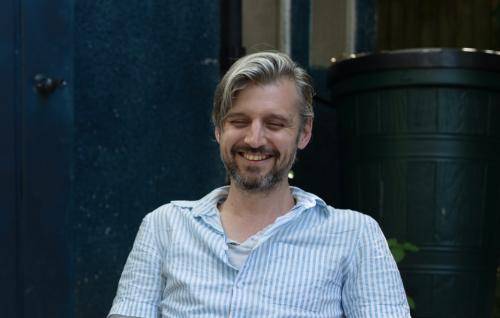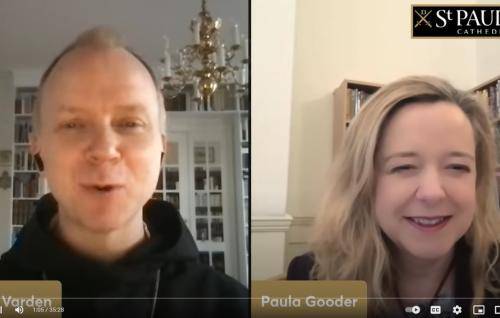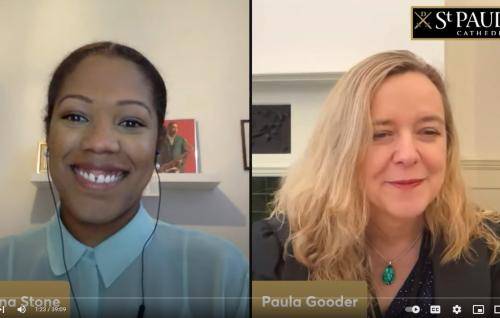To be a Pilgrim
To be a Pilgrim
Andrew Tremlett reflects on pilgrimage for the season of Lent.
1. Starting out
It’s growing on me, this pilgrim thing. I never really saw myself as the ‘type’, if there is such a thing, but somehow it is starting to take root.
I don’t want to sound flippant, but I sometimes do think that different stages of life call for different expressions of spirituality.
And now, after so long in Cathedral ministry, I find myself drawn towards pilgrimage. That sense that there is no escaping the fact that others have trodden here before - a long time before – and that we now stand in their place. We have moved up the queue of those called to be custodians, holders-in-trust today.
A glib metaphor for life, we are pilgrims on a journey, but nonetheless there is deep comfort, connection and coherence about places where others have walked in their thousands and ten thousands over the last millennia.
Looking back, I think it was a visit to the Western Wall of the Temple Mount in Jerusalem, the Wailing Wall which lies beneath the deeply contested Haram Al-Sherif, the third most holy site in Islam, that was a turning point.
As Orthodox Jews were rushing through the narrow lanes of the old city, I found myself in the crowd at the Wall with a group of Christian leaders. And there, in an act of extraordinary hospitality, we were welcomed to pray alongside Jews who were praying for the Peace of Jerusalem.
Not my tradition, I have to say, but there I was writing on a scrap of paper, scribbling an inchoate request for a loved one, and inserting it carefully chosen crack in the stonework. What did I think I was doing? Was God going to come along like some divine janitor to pick up all these scraps and read them one by one?
I really don’t know. What I did know was that there was something profoundly moving going on. A connection between the fragility of my prayer and the permanence of that wall. Between praying alongside a community of which I was no part and the intense feeling of joining an ancient practice. An overwhelming sense that this was the right thing to do without the slightest clue what was going on.
In short, that’s my layman’s guide to pilgrimage.
Something which is viscerally embedded in an ancient past, but somehow points to a life and vitality that is anything but over and done with. An experience which is most often communal – even when it’s not your community – but firmly implanted in the knowledge of one’s person in relation to God.
So, to be a pilgrim, and in these Lent reflections I will draw on Scripture to help us on our journey.
2. On the banks of the River Jordan
Matthew 3.13; Then Jesus came from Galilee to John at the Jordan, to be baptized by him.
But it never rains! That was my first reaction getting off the bus. Jumping down I found myself if not quite knee deep in mud, then certainly in sufficiently claggy soil for it to ooze over my shoes. That was the first impression.
The second impression on arrival at the River Jordan was that it was a tad more busy than I had expected. I had in my mind’s eye imagined a place of solitude to which the crowds swarmed, but in a very English and orderly manner. But the group I was leading had managed to collide with the Epiphany celebrations of the Coptic community, and they turned up in their busloads, replete with ululating women and intoning men.
And the third impression was the security. Like a bad night in Newcastle, there were police and army standing around half-waiting for something to kick off. That mixture of surly indifference coupled with threatening menace. You’re never quite sure whether they are there to protect or to intimidate.
And here’s what happened.
Making our way through the mud after a sudden downpour; pressing through the crowds of Oriental Orthodox Christians sipping their Fanta Orange; wearily keeping a distance from the heavy security presence, we made our way down to the river bank, to the supposed site – or at least, one of the supposed sites - of Jesus’ baptism.
The River Jordan was in full flood, though even in full flow, any decent river would put it to shame. We were stood on the Israeli-Palestine side. The far bank – not 10 yards away – was on the Jordan side. Another country.
But what had at a distance sounded like a choir singing in chorus, it became clear was two distinct groups of worshippers. On our side, the Israeli-Palestinian bank, was a group surrounding their Patriarch, a venerable figure almost enclosed in the adoration of the worshippers.
But on the other bank, in Jordan, another country, was a second group of Copts, all responding to the chants, singing antiphonal responses.
It is no exaggeration to say that the width of the Jordan at that point in no way exceeds the width of St Paul’s Quire, and it was like having Dec and Can – Decanal & Cantoris – singing and responding across the baptismal waters, all the while the police on either side making sure that no one made a bid to cross to the other side.
For once it was the church which was united, and the barriers were those of the state which kept them apart.
To be a pilgrim in this Lenten season can be a messy affair. Mud on your boots, strangers for companions, hazards to make your way around.
But what a foretaste of heaven. To hear the glorious company of Apostles praising God in a harmony which transcends the imposition of human or state or geographical boundaries. Now that’s a real picture of what heaven could be like.
3. On the sea of Galilee
Matthew 8.23; And when he got into the boat, his disciples followed him.
There are lots of sights and sounds and smells which are quite bewildering to the pilgrim. Like the sign outside the supposed location of the Sermon on the Mount, ‘Blessed be the Peacemakers’. The sign firmly states that alcohol, knives and guns are banned, which is faintly reassuring and deeply worrying in equal measure.
But there is one place where I think even the hardened cynic will find it difficult not to sense an echo of the living Christ, to feel themselves living in the same land, breathing the same air and looking into the same sky.
And that’s on the Sea of Galilee. Partly the vast size of the water and land mass means that significant change is impossible. Partly that the surrounding countryside remains less developed, and so it is easier to envisage in the time of Jesus.
But after a day exploring the sites of northern Galilee – Capernaum where Jesus taught in the synagogue – the route back was across the lake on a boat.
It has to be said the pilot of the motor boat was also a budding entrepreneur with an alarming range of produce to sell, as well as a flag to match any nationality.
But halfway across the lake, which is up to 8 miles wide, the engines cut out and we began to sing.
And what did we sing? Dear Lord and Father of Mankind, forgive our foolish ways.
And it won’t surprise you to learn that the heart stumbled and the voice faltered at that wonderful verse:
O Sabbath rest by Galilee
O calm of hills above
Where Jesus knelt to share with thee
The silence of eternity
Interpreted by love; Interpreted by love.
Like many, this is my all-time favourite hymn, though I have sometimes wondered why wedding couples insist on having it, usually before they have exchanged vows – ‘Dear Lord and Father of Mankind // forgive our foolish ways!’
The hymn was written by John Greenleaf Whittier (1807 – 1892), an American Quaker poet and an 1830’s advocate of the abolition of slavery in the United States.
Though many slaves were declared free by President Abraham Lincoln's 1863 Emancipation Proclamation, their post-war status was uncertain. The 13th Amendment to the Constitution declared that "Neither slavery nor involuntary servitude, except as a punishment for crime whereof the party shall have been duly convicted, shall exist within the United States".
The hymn and its writer, then, are a reminder that to be a pilgrim on the Sea of Galilee is nothing about an escape from the pressures of life, looking back to a bucolic existence by the calm waters. Rather this is about acknowledging the transforming presence of Christ which challenges the assumptions of the world and calls us to build the Kingdom.
4. On the Mount of Transfiguration
Matthew 17.1; Six days later, Jesus took with him Peter and James and his brother John and led them up a high mountain, by themselves.
Mount Tabor is spectacular, rising abruptly at the eastern end of the Jezreel Valley. It really looks like a hardened marshmallow which has been unceremoniously dumped in the middle of the valley.
After being dropped off halfway up the mountain, a minibus driver takes you up the steep incline to the summit – and if you didn’t know how to pray before you began, you do by the time you arrive!
And when you arrive, you certainly know you have got there. From the summit you can see for miles around, as far as Tel Aviv and the Mediterranean coast to the West. And a magnificent Franciscan church with a Chapel for Moses and another for Elijah.
Of course, being a pilgrim in this context meant – for James & Peter – a literal companionship with Jesus, accompanying him up the mountain. And we see there two things happening:
First of all, it is revealing Jesus as the successor to Moses and to Elijah. Moses, the great law-giver. Elijah, the great prophet. Both of them are endorsing Jesus. He is their natural successor. Particularly for a Jewish audience that was an incredible and powerful thing to say.
But before we get too misty-eyed – especially when you’re stood on Mount Tabor – let’s remember that Matthew, Mark and Luke also all follow on this Transfiguration scene with a very different one: “The Son of Man is going to be betrayed into human hands, and they will kill him, and on the third day he will be raised.”
In other words, we are not just getting the revelation of Jesus as the successor and fulfilment of the prophets. He is also being revealed as the one who will give up his life for others. Not just the Messiah, not just the Christ. He will take up his cross and become the crucified one.
The poet Malcolm Guite puts this beautifully in his sonnet on the Transfiguration:
For that one moment, ‘in and out of time’,
On that one mountain where all moments meet,
The daily veil that covers the sublime
In darkling glass fell dazzled at his feet.
There were no angels full of eyes and wings
Just living glory full of truth and grace.
The Love that dances at the heart of things
Shone out upon us from a human face
And to that light the light in us leaped up,
We felt it quicken somewhere deep within,
A sudden blaze of long-extinguished hope
Trembled and tingled through the tender skin.
Nor can this blackened sky, this darkened scar
Eclipse that glimpse of how things really are.








